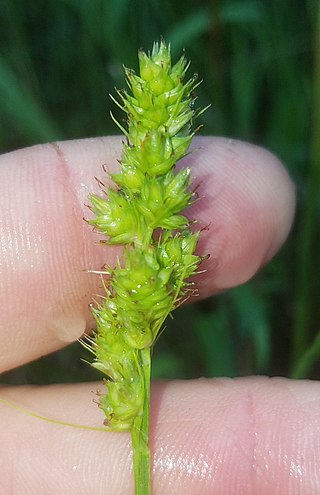
Carex nigra is a perennial species of plants in the family Cyperaceae native to wetlands of Europe, western Asia, north Africa, and eastern North America. Common names include common sedge, black sedge or smooth black sedge. The eastern limit of its range reaches central Siberia, Turkey and probably the Caucasus.

Eriophorum viridicarinatum is a species of sedge known by the common names thinleaf cottonsedge, green-keeled cottongrass, and bog cottongrass. It is native to Canada and the United States.

Ribes americanum is a North American species of flowering plant in the gooseberry family known as wild black currant, American black currant, and eastern black currant. It is widespread in much of Canada and the northern United States.

Carex austrina, known as southern sedge, is a species of sedge endemic to the southern and central United States.

Carex blanda, the common woodland sedge or eastern woodland sedge, is a species of sedge native to a wide variety of habitats in the eastern and central United States and Canada.

Carex davisii, known as Davis' sedge or awned graceful sedge, is a species of Carex native to North America. It is listed as an endangered, threatened, or species of concern across much of edge of its range. It was named in the 1820s by Lewis David de Schweinitz and John Torrey in honor of Emerson Davis (1798–1866), a Massachusetts educator and "enthusiastic student of the genus" Carex.

Carex bromoides, known as brome-like sedge, brome-sedge, and dropseed of the woods, is a species of sedge in the genus Carex. It is native to North America.

Carex woodii, known as pretty sedge, is a species of sedge native to North America.

Carex bicknellii, known as Bicknell's sedge and copper-shouldered oval sedge, is a species of sedge native to North America. Carex bicknellii grows in small clumps with fewer than 25 flowering stems per clump. It is found in mesic to dry prairies, savannas, and open woodlands.

Carex cristatella is a species of sedge native to eastern North America. It is an introduced species in Europe. Carex cristatella is a common species in wetlands such as swamps, marshes, shorelines, and wet prairies.

Carex albolutescens, known as greenish-white sedge or greenwhite sedge is a species of sedge native primarily to the lower Midwest and Eastern United States. C. albolutescens grows in wetlands, with an affinity toward acidic soils in swamps and woodlands.

Carex tenera, known as quill sedge, is a species of sedge native to the northern United States and Canada.

Carex brevior, known as shortbeak sedge and plains oval sedge, is a species of sedge native to North America. The specific epithet brevior means "shorter" in Latin.
Carex suberecta, known as prairie straw sedge, is a species of sedge native to North America.

Carex careyana, commonly known as Carey's sedge, is a species of sedge found in the eastern United States and Ontario, Canada.

Carex lupulina, known as hop sedge or common hop sedge, is a species of sedge native to most of eastern North America.

Carex baileyi is a sedge in section Vesicariae the genus Carex native to the Appalachian Mountains in Eastern North America. It is commonly called Bailey's sedge. Carex baileyi was named in honor of Liberty Hyde Bailey by its discoverer, Nathaniel Lord Britton.

Carex deweyanaDewey's sedge, short-scale sedge, is a species of sedge native to Canada and the United States.

Carex peckii, Peck's sedge, Peck's oak sedge, or white-tinged sedge, is a species of sedge native to Canada and the United States.



















